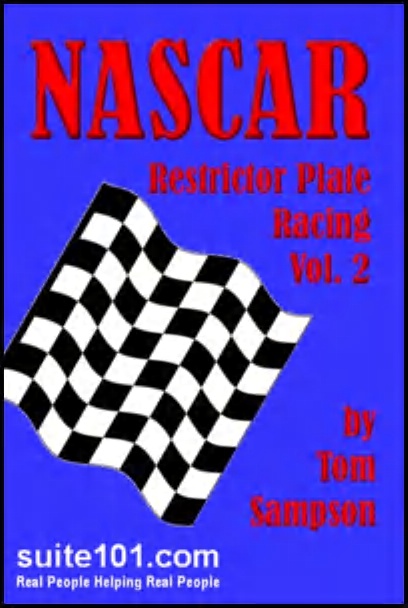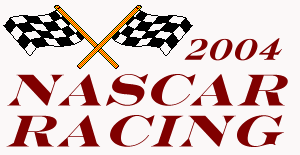in NASCAR
With Tom Sampson
Cup News
Busch News
Truck News
News Archive
Racing Links
Racing Charities
Cup Champions
Busch Champions
Glossary
by Tom Sampson
 Road Racing
Road Racing BUY NOW
 Restrictor Plate #1
Restrictor Plate #1 BUY NOW
 Restrictor Plate #2 BUY NOW
Restrictor Plate #2 BUY NOW
Craftsman Trucks Schedule/Winners ~ Contact |
 AERO PUSH --- When following another vehicle really close, the airflow off the lead vehicle does not travel across the following vehicle normally. The air goes over the top and downward force on the front is lessened resulting in the failure to turn corners normally. The front of the car tends to head for the outside wall resulting in an "aero push." This condition is more apparent on the exit of the turns. The only way to compensate for this is to slow the car down. AERO LOOSE --- This condition affects the racecar when it is in the cornering process. When a racecar makes a close inside pass on another car while maneuvering through a corner, the air gets taken off of its spoiler when the spoiler comes up beside the outside car’s greenhouse, or roof area. This causes the rear of the car to lose grip on the track APRON --- The paved portion at the bottom or inside of a racetrack that separates the racing surface from the infield areas. BANKING --- The sloping of a racetrack which is usually higher near the outside walls than it is toward the infield area, especially in the corners. The degree of banking refers to the track’s height by the outside wall as opposed to its height near the apron. BUMP DRAFT --- When a car drafts behind another (see “draft”) really close and actually pushes the front car. This makes make both, or several, cars faster, and is mostly done in restrictor plate racing. CAMBER --- Camber is the term used for the sideways angle at which a tire makes contact with the track surface. "Positive camber" indicates the top of the tire is tilted away from the car's centerline while "negative camber" indicates the tire is tilted the opposite way. The usual oval track setup has positive camber in the left front and negative camber in the right front, aiding the car in make left-hand turns. CATCH CAN --- A small can with a spout that is used to collect the over-spill or run-off from the fuel overflow port when a racecar is fueled up during its pit stop. Its use is designed to keep the highly flammable 110 octane gasoline from spilling on the back of the car and ground, which would create a fire hazard. CHASSIS --- The bottom of the racecar under the body that includes the springs, shocks, brakes, axels, wheels, etc. CREW CHIEF --- The race team leader at the racing venue. When the race team arrives at the track for an event, the crew chief is in charge of the car and mechanical crew. During the race the crew chief is in charge and makes the decisions regarding pit stops, tire changes, and chassis adjustments. DECK LID --- The term that is used for the trunk lid of a race car. DIRTY AIR --- The term used to describe wild air current turbulence that can cause a race car to lose control. This term is especially used in restrictor plate racing. DNF --- An abbreviation meaning “Did Not Finish.” This relates to a driver or entry that failed to finish any given event. DNQ --- An abbreviation meaning “Did Not Qualify.” This relates to a driver or entry that failed to qualify for any given event. DOWNFORCE --- The pressure caused by air traveling over the surfaces of a race car creates "downforce" or weight on the area. To increase cornering speed teams strive to create downforce that increases tire grip. The tradeoff for increased corner speeds derived from greater downforce is increased drag that slows straightaway speeds. DRAFT --- This term refers to a gap in air currents left by a vehicle traveling at high speeds. When another car gets closer to the car in front, it faces much less wind resistance while in the “draft” of the car ahead of it. Riding in the draft, or “drafting” behind another car, creates more speed per horsepower, and also relieves fuel usage. DRAG --- Also known as “aerodynamic drag.” This constitutes how efficiently a cars body travels through the air and has a lot to do with a cars horsepower efficiency. A box shaped sedan has much more drag than a sleekly shaped sports car. DYNO --- A term used to in reference to a “dynamometer,” which is a computerized machine used to measure an engines horsepower. EQUALIZED --- On race tracks over 1 mile in length, racecars use tires with inner liners which hold more air pressure than the regular tire pressure in the tire (outer liner). When the pressure is lost in the inner liner and the pressure becomes the same in both liners, the tire becomes “equalized,” usually causing a bad vibration. FLAG STAND --- This is where the head race official or flagman runs the race from with the use of different colored racing flags. The flag stand is located in front of the grandstand right above the start/finish line, across the racetrack from the pit area. FUEL CELL --- The racecar’s gas tank, which is mounted under the deck lid, consisting of a metal box containing a foam baffled tear resistant rubber bladder that holds the fuel. The usually unbreakable fuel cell was developed to help prevent fires in racecar crashes. GREENHOUSE --- The section of the racecar under the roof extending from the windshield to the back window, which includes the driver and roll cage area. HORSEPOWER --- A term used in reference to the measurement of mechanical or engine power that it takes to move 33,000 pounds one foot in a minutes time. LOOSE --- When the back end of the car loses traction and slides around to the right toward the outside wall. This usually happens entering or exiting a corner MARBLES --- These are pieces of tire rubber along with dirt and gravel that has been swept out toward the outside wall by the wind created by the speed of the racecars. When cars drive too close to the walls in corners and get into the “marbles,” they lose traction, and then lose control. PIT BOX --- A designated area marked off for each team to service their racecars during a race. The pit area is usually across from the grandstand and flag stand (finish and start line) except for the older smaller tracks where the venue’s size dictates having pit areas on the back stretch. PIT ROAD --- The paved road leading across the apron from the racetrack leading to each team’s pit area where they can service their cars during a race. PIT ROAD SPEED --- A speed limit placed on pit road by NASCAR to insure a safer working environment for team crew members. The speed limit varies depending on the size of the track, usually between 35 and 55 miles per hour which is measured by the racecar’s RPM gauge because racecars don’t have speedometers. PIT STOP --- When a racecar stops for service during competition for fuel, tires, chassis adjustments and mechanical problems. PROVISIONAL --- A starting spot awarded to a driver who did not qualify for a race based on his speed. NASCAR awards starting positions 37 thru 42 using this system. These provisional starts need to be earned through past performances. The 43rd position is left for a past champion who was unable to qualify. If there are no past champions who need to use it, the position is used with the regular provisional starts. RESTRICTOR PLATE --- An aluminum plate that is placed between the base of the carburetor and the engine's intake manifold with four smaller sized holes drilled in it that are inline with the four holes in the carburetor. The smaller holes are designed to reduce the flow of air and fuel into the engine's combustion chamber, thereby decreasing horsepower and speed. ROLL CAGE --- The steel tubing cage inside of the race car’s interior that surrounds and protects the driver from impacts or rollovers. ROOF FLAPS --- These flaps are attached to the racecar’s roof and are designed to activate, or flip up, to deter the car from going airborne if it should spin around backwards. In the case of a vehicle turning backwards, the tendency for an uninterrupted flow of air is to create lift. The roof flaps are designed to disrupt that airflow in attempt to keep the vehicle on the ground. ROUND --- A term used in reference to making chassis adjustments. One turn on a chassis adjustment screw equals one round. It’s also sometimes referred to as a “round of bite” which is made to improve the racecar’s traction and adhesion to the racing surface while cornering. RPM --- A term used in abbreviation that stands for “revolutions per minute,” which is used to measure the turning of an engine’s crankshaft. SCUFFS --- A term used in referring to tires that have been used just enough to have the newness taken off of the contact surface. These “scuffs” have also gone through a heating and cooling process from their first use which can make the rubber compound tougher and longer lasting. SETUP --- "A term used to refer to a racecar’s suspension or chassis adjustments, which include springs, shocks, wheel alignment, etc. Different “setups” or adjustments are required for different sized and different types of racetracks. " SHOCK --- This part is also used within the chassis and is also known as a “shock absorber.” It consists of a rod or piston mounted in a gas filled cylinder. Racecars have specially built shocks that are used to absorb the energy created when the car goes over bumps or rough surfaces on the racetrack. There is a shock mounted with the spring near each wheel. The adjustable stiffness of the shocks also has a lot to do with the setup and handling of a racecar. SPOILER --- The spoiler is an adjustable upright strip of aluminum that stretches across the width of a racecar's rear deck lid. It is designed to create downforce on the rear of the car to increase traction. SPOTTER --- "A team member who is placed in a high position where they can see as much of the entire racetrack as physically possible, which is usually on top of the grandstand area. The spotter relays information to the driver via two-way radio concerning activity on the track and activity near the driver that he is unable to see for himself. " SPRING --- A coiled steel part built in a spiral shape to help the car absorb the bumps and roughness of the racetrack. Some of the older racetracks are really rough and bumpy. The springs are mounted within the chassis near each wheel and are used to hold up the weight of the car. The springs are an intricate part in the equation that is used to determine a racecar’s height. The stiffness of the spring has a lot to do with the racecars setup and handling. SPRING RUBBER --- A two piece rubber wedge that is inserted into the coils of the chassis spring as an adjustment to keep a particular corner of the racecar more rigid for handling purposes. These rubbers are usually inserted before a race, and if required, are removed during tire changes. STICKERS --- A term used for new tires that have the manufacturers plastic nomenclature sticker adhered to the contact surface. SWAY BAR --- An anti-roll bar used in the car’s suspension to counteract the side to side rolling force of a car as it circumvents a corner. TEMPLATE --- A long narrow aluminum device used to check racecar body shape and size. The template is placed over the top of the car from front to rear to insure that it meets the NASCAR specifications associated with that particular make of car. TIGHT --- A condition also known as “push,” that occurs when the front tires of a car will not turn in a corner. The car tends to want to head for the outside wall. When this occurs, the driver must get out of the throttle until the front tires grip the race track again. TOE --- The tire alignment commonly referred to as “castor” which sets the tire to run evenly with the car. If a tire was “toed out” it would wear off the inside portion of the tire tread surface where it touches the ground. If a tire was “toed in” it would wear the outside area of the tire tread surface. A tire must me “in toe” to wear evenly and face the front direction evenly. TRACK BAR --- This bar assembly adjusts the location of the rear end housing. Raising the bar, or moving the rear end to the left, will usually loosen a tight racecar. Lowering the track bar or moving the rear end to the right will usually tighten up the car. TRAILING ARM --- A rear suspension part that allows the axel to be moved either up or down to improve the racecar’s handling and balance. VALANCE --- This is the panel that extends below the vehicle's front bumper towards the ground and is also referred to as the front air dam. The ground clearance affects the amount of front downforce the vehicle creates. Lowering the valance creates more front downforce. WEDGE --- This refers to transferring the weight of the car by the use of jacking screws that are mounted on the rear corners of the racecar. Adjusting these ratcheting screws during a race will alleviate tight and loose conditions. WIND TUNNEL --- A structure used by race teams to determine the aerodynamic efficiency of their cars. It consists of a platform on which the car is fixed, with a giant fan to create wind currents. It contains electronic equipment to determine how the airflow over the car has an affect on drag and downforce. YELLOW LINE --- A painted yellow line that is used to mark the separation of the racetrack from the apron. In restrictor plate races, NASCAR deems it illegal for a car to go below the yellow line or pass another car below the yellow line to gain a track position. |
Privacy and Advertising Policies